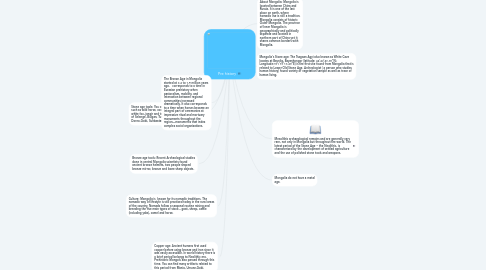Pre history
作者:Gibral Tareeq Haiza

1. Stone age tools: You can find large animals bone such as wild horse, cow, deer, hirs, arslan zaan, white fox, jangir and temeen hyaruul from province of Selenge, Bulgan, Tuv, Uvur-Hangai,Umne-Gobi, Dorno-Gobi, Suhbaatar and Huvsgul.
2. Bronze age tools: Recent Archeological studies done in central Mongolia scientists found ancient bronze helmets, two people shaped bronze mirror, bronze and bone sharp objects.
3. Culture: Mongolia is known for its nomadic traditions. The nomadic way of lifestyle is still practiced today in the rural areas of the country. Nomads follow a seasonal routine raising and breeding the five main types of stock – goat, sheep, cattle (including yaks), camel and horse.
4. Copper age: Ancient humans first used copper before using bronze and iron since it was easily accessible. In world history there is a brief period belongs to Neolithic era. Prehistoric Mongols also passed through this time. You can find many artifacts related to this period from Mania, Umune-Gobi.
5. The Bronze Age in Mongolia started at 2.4 to 1.5 million years ago. corresponds to a time in Eurasian prehistory when pastoralism, mobility, and interaction between regional communities increased dramatically. It also corresponds to a time when horses became an integral part of ceremonies at impressive ritual and mortuary monuments throughout the region—monuments that index complex social organizations.
6. About Mongolia: Mongolia is located between China and Russia. It is one of the last place on earth, where nomadic live is still a tradition. Mongolia consists of historic Outer Mongolia. The province of Inner Mongolia is geographically and politically separate and located in northern part of China yet it shares common borders with Mongolia.
7. Mongolia's Stone age: The Tsagaan Agyi also known as White Cave locates at Baynlig, Bayanhongor (latitude: 44'42'43.30"N; Longitude:101'10'13.40"E) is the first site found from Mongolia that is related to Lower Old Stone Age. Archeologist ( a person who studies human history) found variety of vegetation sample as well as trace of human living.
8. Mesolithic archaeological remains and are generally very rare, not only in Mongolia but throughout the world. The latest period of the Stone Age ~ the Neolithic, is characterised by the development of settled agriculture and the use of polished stone tools and weapons.
9. Mongolia do not have a metal age.


